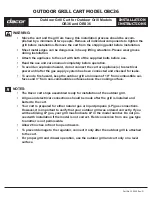
⑤
Setup of functions and beam alignment
Refer to Functions description for detailed explanation
of each option.
Supply power with cover off.
Set function options.
Adjust optical angle
12
- Look through view finder on either side of the upper
transmitter optical unit and move until the receiver
unit is visible.
- Repeat the procedure for the lower optical unit, then
repeat on receiver.
12
A
- View Finder
12
B
- Horizontal fine adjustment screw
12
C
- Vertical adjustment screw
12
D
- Adjustment dial
Fine tuning
12
Initial beam alignment can be achieved by using the
alignment tone indicator.
- Attach the shading plates (located at the sides of
both TX / RX) to the lower optics of both TX and RX.
- Turn the receiver alignment tone switch to ON.
- Adjust the optics with the adjustment screws until
the highest tone is reached. (Note: There will be no
sound if the attenuation alignment tone LED lights
up.)
- Reverse the procedure, i.e. attach shading plates to
upper optics of T / R and repeat adjustment.
- After the adjustment, replace the shading plates in
the retaining areas of TX / RX.
- Turn the alignment tone indicator to OFF.
12
E
- Sensitivity attenuation LED (lights up when
beam reception is below minimum level)
12
F
- Alignment tone switch
12
G
- Monitor jack
Beam alignment using voltmeter
12
H
Precise alignment can be achieved by using a
voltmeter (10VDC). Connect the leads from the
voltmeter to the monitor jacks of the receiver. The
measurings for alignment are as follows.
12
H
- Voltmeter (10VDC)
Voltage reading
Alignment
2.7V or more
Best
2.0V to 2.7V
Good
2.0V or less
Poor, re-adjust
Attach cover
- Attach transmitter cover first.
- Confirm that receiver sensitivity attenuation LED
remains OFF. Place cover in position, but do not
secure. A ”beep” sound will occur after five seconds.
After this signal, secure the receiver cover with
screws.
Sensitivity allowance is automatically set when
the beep sound is initiated.
If the sound alignment switch is left ON
accidentally, the sound will cease when the
receiver cover is attached.
- If there is a continous ”beep” sound, detach the
receiver cover and re-adjust it, referring to the
auto-gain lock function.
Operation check
13
After installation, alignment and auto-gain set, test
operation by a walktest of the beam. Two methods
may be used:
Alarm LED only.
Alarm LED and sound check by means of the sound
alignment switch. If the sound alignment switch is
set to ”ON”, the sound will stop when the cover is
replaced but be effective for an audible operation
test for five minutes after the auto-gain is locked.
13
A
: Check by alarm LED
13
B
: Check by walk test mode
Functions description
Auto-gain lock function
15
The auto-gain lock serves to standardize the
responsiveness and tolerance level of the units,
regardless of the varying distance in an installation.
- The situations in
15
have exactly the same
tolerance and responsiveness levels although the
distances differ.
A ”beep” sound is issued from the receiver
approximately five seconds after the cover is put into
position. This sound indicates that the auto-gain has
been set. Refer to the chart below.
Sound
Indicates
Result Cause
Remedy
One pulse
(beep)
Optimal
sensitivity has
been set.
OK -
-
Continous
tone (20
seconds)
Optimal
sensitivity
cannot be set.
not
good
⇩
1. Beam is interrupted once cover is replaced.
2. Beams are misaligned and sensitivity
attenuation LED lights up.
1. Remove any obstacle. Ensure that the hand does not
interrupt the beam when holding cover in temporary position.
A sound is generated regardless whether the
”beep” (alignment sound) switch is set to ON or
OFF.
The auto-gain setting is locked even if power is
disrupted.
When the receiver cover is detached while power
is supplied, the auto-gain is automatically reset
to maximum sensitivity.
Test / Signal
Alignment sound switch
Other condition
Description
Beam
align-
ment
ON
Receiver
cover
detached
Reception strength
monitored. Sound pitch
increases as
reception improves.
Note: No sound is
present when sensitivity
attenuation LED lights
up or when receiver
cover is attached.
Walk test ON Approx
5 min. after
gain is locked
Sound is linked to alarm
LED. Both trip
simultaneously
Auto-
gain lock
ON
or
OFF
After receiver
cover is
attached
Short sound indicates
lock is set.
Continuous sound
(20sec.)
indicates readjustment.
Response time changeover function
8
This feature can be used to alert the response time of
the beam to best fit the application. Use the 0.7sec
setting with caution. Non-detection of fast moving
human being could result.
Alarm output
10
NC or NO signal output can be selected. (Contact
capacity 30V (AC/DC) or less.)
Alarm memory function
⇩
Functions
Function switches
“Beep” alignment tone
ON
OFF
Response time adjustment
0.05 sec. (standard)
0.3 sec.
0.7 sec.
Others
Alarm output
N.O.
N.C.
Alarm memory
Timer mode
OFF
Tone indicator
This feature provides audible testing of signals for the
following items:
The alarm memory LED indicates which sensor was
triggered when two or more sensors are placed on a
zone.
Reset can be automatic.
Timer mode
(Set TIMER for Memory Selector)
Alarm memory function
Alarm output
Memory LED
60 min.(re-trigger)
5 min.
5 min.
55 min.(flickering)
(TIMER
←
→
OFF)
Memory selector
Timer mode
- The memory LED will light ve minutes after an alarm
signal and then continue to icker for 55 minutes
before returning to normal mode. If additional alarm
signal are triggered, the process repeats.
Estimated battery life
No. of pair
Md AA
0.5Ah
Gel Cell
1.0Ah
Gel Cell
5.0Ah
1
8 hr
16 hr
83 hr
2 -
8
hr
41
hr
4 -
-
20
hr
8 -
-
10
hr
No. of pair
Md AA
0.5Ah
Gel Cell
1.0Ah
Gel Cell
5.0Ah
1
7 hr
14 hr
71 hr
2 -
7
hr
35
hr
4 -
-
17
hr
8 -
-
8
hr
No. of pair
Md AA
0.5Ah
Gel Cell
1.0Ah
Gel Cell
5.0Ah
1
5 hr
11 hr
58 hr
2 -
5
hr
29
hr
4 -
-
14
hr
8 -
-
7
hr
Unit should be connected to a listed class 2 power
source capable of providing standby power for at
minimum 4 hours.
PB-50FA
PB-100FA
PB-200FA






































